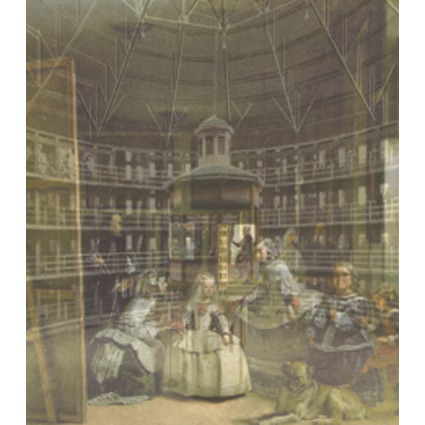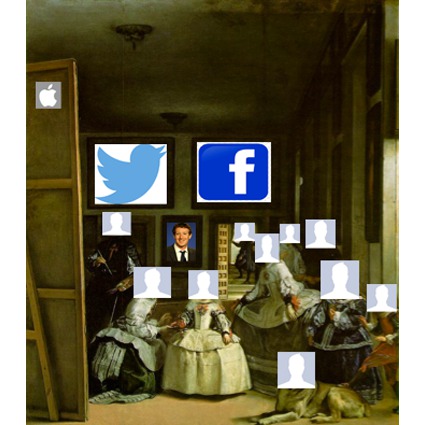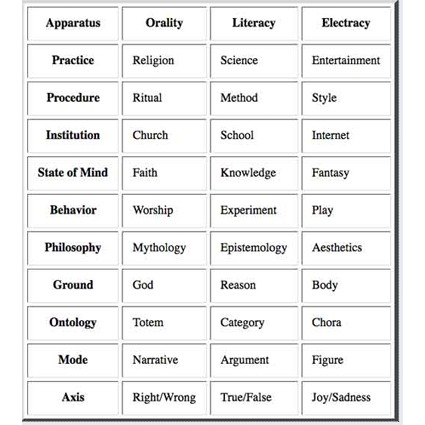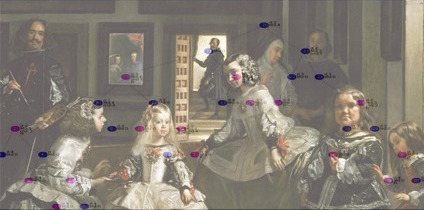The Rhetoric of Desiring-Surveillance: Diego Velázquez’s Las Meninas, Subjectivity, and Media(ted) Vision in the Age of Electracy
 Sunday, March 6, 2016 at 9:02PM
Sunday, March 6, 2016 at 9:02PM Scott Sundvall
[ PDF Version ]
Introduction: Where We’ve Been, Where We’re Going
In the introduction of Liquid Surveillance, sociologist David Lyon notes that surveillance is widely considered to be a “central dimension of modernity.”[1] Yet, much of the colloquial and intellectual discourse around surveillance focuses on the emergent and contemporary (including drones, dataveillance, and satellites) and the political, ethical, and juridical (Who has the right to perform surveillance? To what extent, when, and why?). These approaches stem from valid concerns and pursue important lines of inquiry, but they also often rely on the same loaded assumption: surveillance is something that we ought to resist. Especially with the advent of ubiquitous computing (ubicomp), which has redoubled the formation of what Zygmunt Bauman calls a “liquid modernity,” popular resistance to surveillance seems ambivalent at best.[2] As opposed to vertical conceptions and practices of surveillance in previous historical epochs, in which the sovereign monitors the subjects, the rapid growth and liquid-like character of ubicomp has created a radical, horizontal expansion of surveillant vision that demands a practical and conceptual rethinking of surveillance itself.
In the age of what Gregory Ulmer calls “electracy,”[3] the symptoms of this new social apparatus are becoming ubiquitous. We can use social media platforms to share status updates, “check in” at GPS-mapped locations, and quantify “success” according to the number of followers or friends one has. Ready-to-hand access to digital recording also allows subjects to record abuses of power, as we have seen with the rampant increase in police brutality documentation., In addition, the development of augmented reality continues to enhance the virtual potential of the actual and material sphere colloquially known as “meatspace.” In response to these technological and social developments, I slightly depart from recent scholarship in surveillance studies and argue that we first and foremost desire to see others and to be seen by others.[4] I refer to this emergent frame of mind as “desiring-surveillance.”
This article has two central aims. First, it seeks to situate the relational birth of modern subjectivity, desire-aesthetics, and surveillance by linking Michel Foucault’s ekphrasis of Diego Velázquez’s Las Meninas to the logic of Jeremy Bentham’s panopticon. Second, via the agreeable conjunction of Gilles Deleuze and Félix Guattari’s "schizoanalysis" and the "third sophistic,"[5] I establish a rhetorical shift from literate “subject” to “electrate” brand and note the implications of such a move for surveillance studies.
Seeing the Seeing: Diego Velázquez’s Las Meninas and Jeremy Bentham’s Panopticon

Figure 1. Diego Velázquez, Las Meninas (1656). Creative Commons.
Artists, visual art scholars, historians, semioticians, rhetoricians, and philosophers have written much about and theorized much upon Velázquez’s Las Meninas. Regardless of nuanced differences in interpretation, there is almost universal consensus that the work presents a definitive portrait of the formation of Enlightenment subjectivity, vision, representation, and desire. Michel Foucault’s ekphrasis of Las Meninas in The Order of Things begins by noting the first and arguably most fundamental rhetorical claim in the painting: the Enlightenment arrangement of the ubiquitous, multiplicative, destabilized gaze that is compounded by the act of representation. Aside from the various gazes within the narrative of the painting, “we [also] see the painter observing us.”[6] In short, “we are looking at a picture in which the painter is in turn looking at us.”[7] This produces a “slender line of reciprocal visibility [that] embraces a whole complex network of uncertainties, exchanges, and feints.”[8] Foucault notes that such an observation gestures to the obfuscation of a unilateral, enframed gaze and representation, and blurs the lines between being-seen and seeing. He writes, “No gaze is stable, or rather, in the neutral furrow of the gaze piercing at a right angle through the canvas, subject and object, the spectator and the model, reverse their roles to infinity.”[9] Foucault likens this shift in subject vision and representation to a window. It allows us to see others seeing us, and vice versa.

Figure 2. Diego Velázquez, Las Meninas (1656) and a rendering of Jeremy Bentham’s Panopticon. Creative Commons. Modified: Las Meninas layered with Panopticon.
In terms of discourse archaeology, the implications of this shift reach infinitely far and wide, and include the modern development of surveillance modalities. Foucault notes that “we are observing ourselves being observed,” which causes “our image . . . to be imprisoned.”[10] The metaphysics of picture qua window offers up a potential logic that Bentham’s panopticon appropriates. As Foucault explains in Discipline and Punish, the spatial structuring of the panopticon allows a guard to potentially observe any given prisoner at any given time. In short, “Inspection functions ceaselessly. The gaze is alert everywhere.”[11]
Thus, the logic of the panopticon echoes the rhetoric in Foucault’s ekphrasis of Las Meninas. Foucault concludes that the painting visualizes the discourse formation of the modern subject by and for the sovereign who is not necessarily visible but nonetheless present. Conjoined with the ubiquity, multiplicity, and destabilization of the gaze, the painting also represents “spectacle-as-observation.” After all, the “centre [of the painting] is symbolically sovereign, since it is occupied by King Phillip IV and his wife,” albeit through their unseen presence.[12] For Foucault, this mirrors the primary objective of the panopticon, which is “to induce in the inmate a sense of conscious and permanent visibility that assures the automatic functioning of power” and establish surveillance that is “permanent in its effects, even if discontinuous in its action.”[13] In both cases, then, the Enlightenment construction of subject and subject-representation (which involves documentation and surveillance) remains primarily rooted in the sovereign’s desire. This construction extends from the epistemology of aesthetics (as in Las Meninas) to the scientific method and power-logic that manifest in the panopticon.
Deleuze and Guattari’s most primary ontological assertion—“There is only desire and the social, and nothing else”—is thus an apt conclusion to this section.[14] Whether it is through the metaphysical desire-aesthetics of Las Meninas or its appropriation via the scientific logic of the panopticon, one can historically map the formation of modern surveillance by way of desire. Likewise, we can approach earlier instances of media (such as classical painting) as mediation to note that media and surveillance have always been linked and have always been a rhetorical formation. One desires to see and be seen first (desiring-surveillance); assemblages of power only secondarily appropriate the primacy of this desire into various surveillance machines and modalities. As such, the rhetorical architecture of the panopticon is just that—rhetorical. The panopticon first takes shape as a method or strategy (expression) and only thereafter as a physical structure that actualizes this method or strategy in form (content). As the next section will explore, if surveillance discourse is calling for a move beyond the panopticon model, it is because such discourse has not fully understood the panopticon as a social architecture and the logico-rhetorical appropriation of desire-aesthetics represented in, and representative of, Las Meninas.
From Las Meninas Windows to Microsoft Windows: Subjectivity and Surveillance in Electracy

Figure 3. Diego Velázquez, Las Meninas (1656). Creative Commons. Modified: Las Meninas in digital social media.
Much as the above section denoted an epochal shift in subjectivity, representation, and surveillance during the Enlightenment period, Ulmer’s development of electracy allows one to consider another shift already underway: from orality to literacy to electracy. This latest phase is indicated by the shift toward apparatuses like film, television, and, most recently, ubicomp. Presenting the concept of electracy in Teletheory, Ulmer writes, “Part of the project of teletheory is to imagine a different apparatus, beginning with a different technology. My assumption is that to inquire into the future of academic discourse in the age of a new technology we must include the possibility of a change not only in technology, but also in the ideology of the subject and the forms of institutional practice.”[15] Ulmer suggests that the rapid development of electronic technologies, specifically digital technologies, has impacted culture so extensively that we need to radically adjust our conceptions, understandings, and practices of the humanities at large. As the image below illustrates, electracy implicates all discourse formations and necessarily pervades subjectivity (or selfhood) and, by extension, surveillance.

Figure 4. Gregory Ulmer, “The Learning Screen—Introduction: Electracy.” Source: Networked.
Particularly noteworthy here are the shifts from science to entertainment, method to style, knowledge to fantasy, epistemology to aesthetics, argument to figure, and true/false to joy/sadness. Accompanying his articulation of these shifts, Ulmer’s Heuretics blog proposes the following analogy: “Literacy = school/concept/self :: Electracy = internet/emblem/brand.”[16] As such, electracy indicates a transition from modern subjectivity qua self to brand. In other words, as opposed to the concept of a subject, the formation of an electrate persona concerns not interior depth, but rather the networked surfaces that are typified by the “digital persona.” Electracy abandons the prescription of science and the scientific method for entertainment and style, a shift one can detect in the packaging and delivery of mass-media news, for example. One no longer harbors the priority of epistemological appropriation of aesthetics, but the reverse. (Consider Las Meninas inverted, perhaps in the form of television shows such as COPS or America’s Most Wanted.) Last but not least, in the context of electracy, the truth-content of one’s essential self gives way to the dynamics of joy and sadness. That is, consider not what Las Meninas reveals about the truth (or falsity) of subjectivity and representation, but how the visual arts diminish or augment human capacities.[17]
Many surveillance scholars have also noted that the Internet in general, and social media in particular, present the clearest examples of the relationship between this epochal erasure of subjectivity and surveillance that I call “desiring-surveillance.” Bauman and Lyon suggest that liquid modernity, which is akin to Ulmer’s electracy, ushers in a “confessional society” in which “we seem to experience no joy in having secrets.”[18] Such a “desire for more and more surveillance,” they further argue, updates the Cartesian cogito to ““I am seen (watched, noted, recorded) therefore I am.””[19] Or, I might argue, it marks a shift from Being to Beseen. Andrejevic explains that one result of ubicomp is “increasing public access to the means of surveillance—not just by corporations and the state, but by individuals.”[20] For Andrejevic, Ubicomp’s interactivity “enables an emergent culture of peer-to-peer monitoring” that participates in the modality of “lateral surveillance.”[21] The diffusive redistribution of surveillance tasks renders all of us suspects and spies, as exemplified by the exigency of the post-9/11 Department of Homeland Security mantra, “If You See Something, Say Something.” Relatedly, Phillipe-Joseph Salazar’s “Subjectivity Under Surveillance” suggests that “rhetoric and political subjectivity are indivisible.”[22] For him, contemporary surveillance modalities flatten subjects into objects, and that such a flattening corrodes a healthy democracy.[23] On a more optimistic note, Albrechtslund’s “participatory surveillance” “look[s] at online social networking and the idea of mutuality . . . [as] not about destructing subjectivity or lifeworld. Rather, this surveillance practice can be part of the building of subjectivity and of making sense in the lifeworld.”[24]
The above examples either explicitly or implicitly covet the Enlightenment construction of subjectivity and the philosophically tired concept of privacy. They also retain a top-down approach to surveillance, and/or posit an ethical critique built around the assumption of subjectivity and privacy. As Deleuze and Guattari note in What Is Philosophy?, “Subject and object give a poor approximation of thought. Thinking is neither a line drawn between subject and object nor a revolving of one around the other.”[25] Rather, they argue, we do not constitute individual subjects so much as “desiring-machines”—“real ones, not figurative ones: machines driving other machines, machines being driven by other machines, with all the necessary couplings and connections. An organ-machine is plugged into an energy-source-machine: the one produces a flow that the other interrupts.”[26] Plugged into the electrate institution of the Internet—with the corollaries of entertainment, style, fantasy, play, and joy or sadness—our desiring-machines take on the quality of brand and mimic the logic of celebrity. As brand, exposure and visibility are especially desired features. Andrejevic correctly identifies this “savvy recognition of the staging of the self,” wherein “surveillance as a form of entertainment is perhaps not unfamiliar to a generation raised on reality shows like MTV’s The Real World.”[27]
As electrate brands playing on the panoptic stage of ubicomp, we retain the ubiquitous, multiplicative, destabilized gaze from Enlightenment-era modernity, but nonetheless deface the priority of subjectivity that sovereigns have ordained. We move from the vertical, top-down techniques of power to the horizontal desire-aesthetics of brands seeing brands that characterizes desiring-surveillance. As such, we must also move from a purely ethical approach and critique of surveillance to one that properly concerns desire-aesthetics. One issue with such ethical approaches, Andrejevic notes, is “the tendency to think of privacy as possession, something that can be acquired, surrendered, or exchanged”—a sense that “they” (governments, corporations, or whatever assemblages of power) are out to get each “our” secrets.[28] Deleuze and Guattari note that secrets always take on a “virile paranoid form.”[29] This may manifest as the paranoiac-despot who tries to gather a paranoid subject’s secrets or a paranoiac-despot who hides secrets from a paranoid subject. Such a paranoiac approach to ethics, which is predicated on the coveting of an overdetermined subjectivity, does not fit within an electrate framework and only reproduces what it otherwise resists. As the post-9/11 modalities of surveillance clearly illustrate, paranoia and fear legitimize the paranoiac-despot, who, in turn, redoubles paranoia and fear.
Instead, Victor Vitanza’s “third sophistic” suggests approaching “the ethico-political horizon . . . by way of poetic/aesthetic view of discourse.”[30] He suggests that “the ethical subject—and consequently how the polis and politics—must be aestheticized so as to get to what has been systematically forgotten”—namely, the third term (desire-aesthetics), which exceeds the biunivocality of ethics (right/wrong).[31] Vitanza further states, “For Nietzsche, then the political-ethical subject is the aesthetic subject. Human beings can be represented only by masks.”[32] Or, in our electrate reformulation, they can only be represented as brands. Insofar as I approach surveillance as desiring-surveillance, as aestheticized brands in playful performance, I ask not how certain surveillance practices fall within the biunivocal framing of ethics, but rather how such practices inform the infinite third term of desire-aesthetics and how they affect our capacities for joy or sadness. Here, it is worth returning to the metaphysics of the gaze in Las Meninas, sans subject-formation and subject-ethics that the sovereign establishes, to understand desiring-surveillance in terms of desire-aesthetics in the networked age of electracy.
As Deleuze and Guattari note, “What is preserved—the thing or the work of art—is a bloc of sensations, that is to say, a compound of percepts and affects.”[33] Ubicomp figures platforms such as social media as surveillance vehicles and delivery systems for brand expression—a surveillance modality that first concerns desire, sensation, and affect. Notably, both the Enlightenment construct of subjectivity and its primary surveillance modality are centered on content (information, representation, documentation). The electrate shift and its primary surveillance modality, however, are centered on expression (entertainment, fantasy, joy/sadness). To this end, the horizontal expansion of surveillance that ubicomp enables cannot be primarily situated in subject-representation or subject-ethics. Rather, it ought to be primarily rooted in the desire-aesthetic sensation of watching and being watched—desiring-surveillance.Admissions and Concessions; or, How I Learned to Stop Worrying and Love Desiring-Surveillance

Figure 5. Diego Velázquez, Las Meninas (1656). Creative Commons. Modified: Rhizomatic mapping of Las Meninas.
None of this means that top-down state and corporate surveillance no longer exists or that we, as a body politic, should not have individual and collective agency in deciding what forms of surveillance ought to be permissible. Rather, it argues that we most often desire surveillance. With the rapid growth of ubicomp, one now bears witness to a horizontal, aesthetic expansion of desiring-surveillance that the state or corporate surveillance modalities only appropriate secondarily. By contrast, arguments that frame surveillance as primarily dystopic, anti-democratic, or objectifying often run into double binds in their conclusions.
To observe the first double bind, consider the classical conception of the polis (a state), which renders an individual as a marked and legible subject. Ironically, many of the contemporary critiques of surveillance, some of which are listed above, claim that the polis infringes on or utterly negates political subjectivity. However, it is counter-productive—if not counter-intuitive—to both champion subjectivity while decrying the polis. This accounts for our abandonment of the political-ethical subject of modernity for the desire-aesthetic brand of electracy and the move from the modern polis to the electrate chora.
Similarly, the desiring-surveillance of brand-towards-celebrity also reaches a double bind. For example, the paparazzi (as an electrate surveillance modality) might be resisted by celebrities, but the paparazzi also afford celebrity in the first place. First and foremost, vertical, top-down surveillance techniques are afforded by and even predicated on an ever-expanding, horizontal, brand-to-brand desiring-surveillance. The ubiquity of desiring-surveillance extends to power techniques of the state and the logic of capital, with the panopticon’s figurative appropriation of Las Meninas serving as one historical example of this. Inasmuch as one harbors a metaphysical desire to see and be seen, the state gathers information and capitalist enterprises attempt to sell us goods more effectively by exploiting one’s primary tendency towards desiring-surveillance. Still, arguments that focus on the logics of state or capitalist surveillance require a structural approach beyond the scope of this article.
And so we might think of that old cliché about having your cake and eating it, too. I do not believe that anyone is being duped or manipulated by surveillance, since, in the words of Deleuze and Guattari, “desire can never be deceived.”[34] As they note in Anti-Oedipus, the masses were never conned into fascism; they desired it. With continued technical innovation in the age of electracy, Deleuze’s vision of a “control society” becomes all the more palpable.[35] As Paul Virilio warns that the invention of the ship invariably invents the shipwreck, the inauguration of electracy also invents the potential for electric shock, for total surveillance.[36] But it will only come to fruition if we desire such a future—even if that desire is ultimately a desire-repressing-desire.

Figure 6. Diego Velázquez, Las Meninas (1656). Creative Commons. Modified: Las Meninas subjects-under-erasure.
Notes
[1] Zygmunt Bauman and David Lyon, Liquid Surveillance: A Conversation (Malden, MA: Polity, 2013), 1.
[2] Ibid.
[3] Gregory Ulmer, Teletheory: Grammatology in the Age of Video (1989; New York: Atropos Press, 2004).
[4] Prime examples of this include Bauman and Lyon’s “liquid surveillance,” Mark Andrejevic’s “lateral surveillance,” Anders Albrechtslund’s “participatory surveillance,” Steve Mann’s “co-veillance,” Reg Whitaker’s “participatory panopticon,” and Clay Colvert’s “voyeur nation.” See Bauman and Lyon, Liquid Surveillance; Mark Andrejevic, iSpy: Surveillance and Power in the Interactive Era (Lawrence, KS: University Press of Kansas, 2007); Anders Albrechtslund, “Online Social Networking as Participatory Surveillance,” in First Monday 13, no. 3 (March 2008), http://firstmonday.org/article/view/2142/1949; Steve Mann, Jason Nolan, and Berry Wellman, “Sousveillance: Inventing and Using Wearable Computing Devices for Data Collection in Surveillance Environments,” in Surveillance & Society 1, no. 3: 331-355 (2003); Reg Whitaker, The End of Privacy: How Total Surveillance is Becoming a Reality (New York: The New Press, 1999); Clay Colvert, Voyeur Nation: Media, Privacy, and Modern Culture (New York: Basic Books, 2000).
[5] Victor Vitanza, Negation, Subjectivity, and the History of Rhetoric (Albany, NY: State University of New York Press, 1997); D. Diane Davis, Breaking Up [at] Totality: A Rhetoric of Laughter (Carbondale, IL: Southern Illinois University Press, 2000).
[6] Michel Foucault, The Order of Things: An Archaeology of the Human Sciences, trans. Alan Sheridan (1970; New York: Random House, 1994), 4.
[7] Ibid.
[8] Ibid.
[9] Ibid., 5.
[10] Ibid., 6.
[11] Michel Foucault, Discipline and Punish: The Birth of the Prison, trans. Alan Sheridan (1977; New York: Random House, 1995), 195.
[12] Foucault, The Order of Things, 14.
[13] Foucault, Discipline and Punish, 201.
[14] Gilles Deleuze and Félix Guattari, Anti-Oedipus: Capitalism and Schizophrenia, trans. Robert Hurley (Minneapolis: University of Minnesota Press, 1983), 29.
[15] Ulmer, Teletheory, 21.
[16] Gregory Ulmer, “Electracy: Inventing Heuretics,” http://heuretics.wordpress.com/electracy. Emphasis added.
[17] It should be noted that Ulmer’s notation of the subject-under-erasure, even in this specific sense, is, not by any means, exclusive to electracy. Several other theorists have detailed similar construct shifts, including Donna Haraway with the “cyborg,” Jordan Crandall with the concept of “body-machine-image,” Scott Bukatman with the “virtual subject,” Alexander Galloway with “leaving-being,” and Mark Hansen with the “affective body.”
[18] Bauman and Lyon, Liquid Surveillance, 30, 28.
[19] Ibid., 116, 130.
[20] Andrejevic, 212, 213.
[21] Ibid.
[22] Phillipe-Joseph Salazar, “Subjectivity Under Surveillance: Rhetoric Redux,” Centre Francais de Reserche sur le Reseignement, Jan. 31, 2015, http://www.cf2r.org/fr/tribunes-libres/subjectivity-under-surveillance-rhetoric-redux.php.
[23] Ibid.
[24] Albrechtslund.
[25] Gilles Deleuze and Félix Guattari, What Is Philosophy?, trans. Hugh Tomlinson and Graham Burchell (1991; New York: Columbia University Press, 1996), 85.
[26] Deleuze and Guattari, Anti-Oedipus, 1.
[27] Andrejevic, 229.
[28] Ibid., 256.
[29] Gilles Deleuze and Félix Guattari, A Thousand Plateaus: Capitalism and Schizophrenia, trans. Brian Massumi (1980; Minneapolis: University of Minnesota Press, 1987), 288.
[28] Vitanza, 58.
[29] Ibid., 103. Italics in original.
[30] Ibid., 106. Emphasis in original.
[33] Deleuze and Guattari, What Is Philosophy?, 164. Emphasis in original.
[32] Deleuze and Guattari, Anti-Oedipus, 257.
[33] Deleuze, “Postscript on the Societies of Control,” October 59 (1992): 3-7.
[36] Paul Virilio, The Original Accident, trans. Julie Rose (New York: Polity Press, 2007), 10.
Scott Sundvall is a doctoral candidate at University of Florida’s English department. His dissertation schizoanalyzes the rhetorical implications of surveillance in the age of electracy. His work has appeared in Itineration, Interstitial, Enculturation, and Politics of Place.
Reader Comments